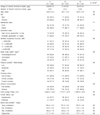Abstract
Purpose
Methods
Results
Conclusion
Figures and Tables
Table 1
General characteristics of the study participants according to tertiles of toenail chromium levels

Values are mean ± SE or n (%). T, tertiles; KRW, Korea Republic Won; METs, metabolic equivalents; LDL, low density lipoprotein; HDL, high density lipoprotein.
1) p values were derived from a chi-square test for categorical variables, and p for trends was derived from generalized linear regression analysis for continuous variables. 2) Body mass index was categorized into < 23 kg/m2 as underweight/normal, 23–24.9 kg/m2 as overweight, and ≥ 25 kg/m2 as obese based on BMI cut-offs for Asians by the World Health Organization.21 3) Physical activity level was calculated as a weekly METs-hour, and it was categorized into < 20 METs-h/week as low, 20–39 METs-h/week as moderate, and ≥ 40 METs-h/week as high. 4) Values are age and sex-adjusted mean ± SE.
Statistical significance is defined as *p < 0.05, **p < 0.01, ***p < 0.001, and NS stands for not significant.
Table 2
General characteristics of the study participants with and without dyslipidemia

Values are mean ± SE or n (%). KRW, Korea Republic Won; METs, metabolic equivalents.
1) p values were derived from a chi-square test for categorical variables, and p for trends was derived from generalized linear regression analysis for continuous variables. 2) Body mass index was into < 23 kg/m2 as underweight/normal, 23–24.9 kg/m2 as overweight, and ≥ 25 kg/m2 as obese based on BMI cut-offs for Asians by the World Health Organization.21 3) Physical activity level was calculated as a weekly METs-hour, and it was categorized into < 20 METs-h/week as low, 20–39 METs-h/week as moderate, and ≥ 40 METs-h/week as high. Statistical significance level is defined as *p < 0.05, **p < 0.01, ***p < 0.001, and NS stands for not significant.
Table 3
Dietary and non-dietary correlates of toenail chromium levels

Multivariable-adjusted findings including each of the variables in the table. Independent dietary predictors were identified using stepwise regression. KRW, Korea Republic Won; METs, metabolic equivalents.
1) Body mass index was into < 23 kg/m2 as underweight/normal, 23–24.9 kg/m2 as overweight, and ≥ 25 kg/m2 as obese based on BMI cut-offs for Asians by the World Health Organization.21 2) Physical activity level was calculated as a weekly METs-hour, and it was categorized into < 20 METs-h/week as low, 20–39 METs-h/week as moderate, and ≥ 40 METs-h/week as high.
Statistical significance level is defined as *p < 0.05, **p < 0.01, ***p < 0.001, and NS stands for not significant.
Table 4
Odds ratio and 95% confidence interval for dyslipidemia and its components according to toenail chromium levels

T, tertiles; LDL, low density lipoprotein; HDL, high density lipoprotein. Model 1: unadjusted; Model 2: adjusted age, sex, and body mass index; Model 3: additionally adjusted for education level, smoking status, alcohol consumption, physical activity, monthly household income, residential area, and total energy intake; Model 4: additionally adjusted for family history of hypertension and diabetes.
Statistical significance level is defined as *p < 0.05, **p < 0.01, ***p < 0.001, and NS stands for not significant.
Notes
This work was supported by Basic Science Research Program through the National Research Foundation of Korea (NRF) funded by the Ministry of Science, ICT & Future Planning (NRF-2017R1A1A3A04069759). The funder had no role in study design, data collection and analysis, decision to publish, or preparation of the manuscript.




 PDF
PDF ePub
ePub Citation
Citation Print
Print


 XML Download
XML Download